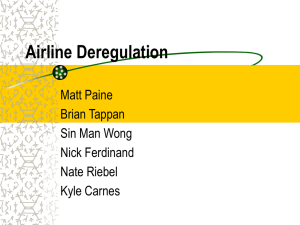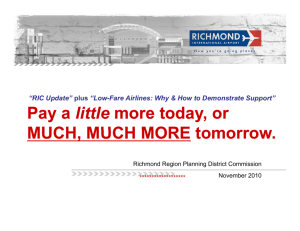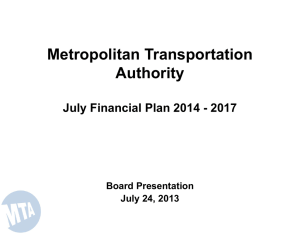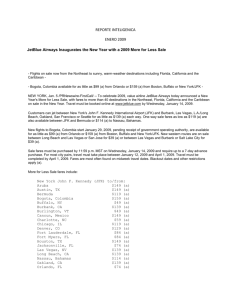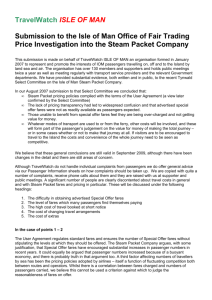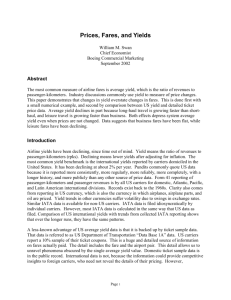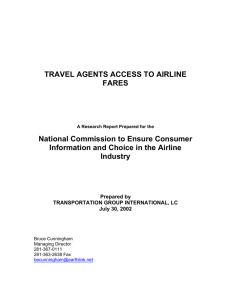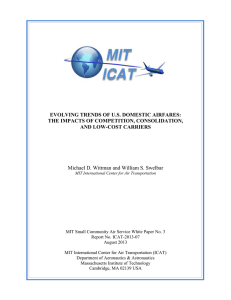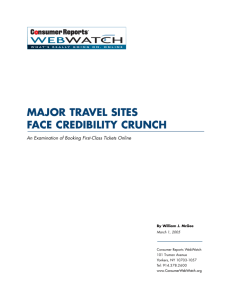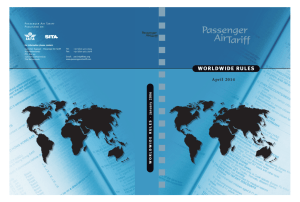108
advertisement
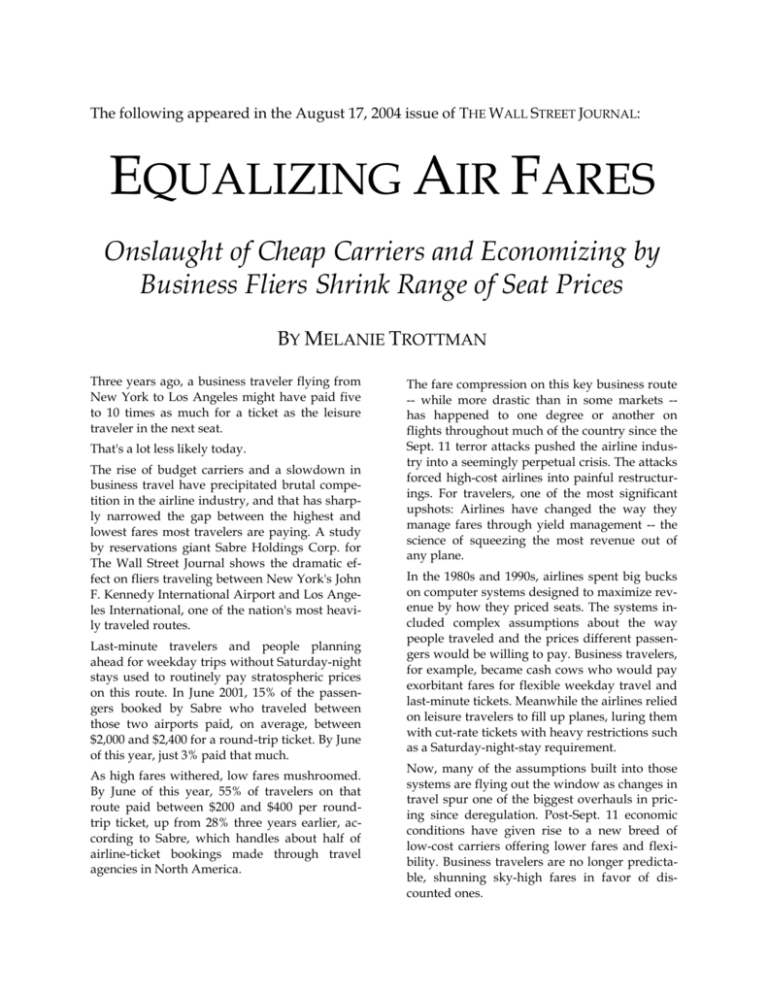
The following appeared in the August 17, 2004 issue of THE WALL STREET JOURNAL: EQUALIZING AIR FARES Onslaught of Cheap Carriers and Economizing by Business Fliers Shrink Range of Seat Prices BY MELANIE TROTTMAN Three years ago, a business traveler flying from New York to Los Angeles might have paid five to 10 times as much for a ticket as the leisure traveler in the next seat. That's a lot less likely today. The rise of budget carriers and a slowdown in business travel have precipitated brutal competition in the airline industry, and that has sharply narrowed the gap between the highest and lowest fares most travelers are paying. A study by reservations giant Sabre Holdings Corp. for The Wall Street Journal shows the dramatic effect on fliers traveling between New York's John F. Kennedy International Airport and Los Angeles International, one of the nation's most heavily traveled routes. Last-minute travelers and people planning ahead for weekday trips without Saturday-night stays used to routinely pay stratospheric prices on this route. In June 2001, 15% of the passengers booked by Sabre who traveled between those two airports paid, on average, between $2,000 and $2,400 for a round-trip ticket. By June of this year, just 3% paid that much. As high fares withered, low fares mushroomed. By June of this year, 55% of travelers on that route paid between $200 and $400 per roundtrip ticket, up from 28% three years earlier, according to Sabre, which handles about half of airline-ticket bookings made through travel agencies in North America. The fare compression on this key business route -- while more drastic than in some markets -has happened to one degree or another on flights throughout much of the country since the Sept. 11 terror attacks pushed the airline industry into a seemingly perpetual crisis. The attacks forced high-cost airlines into painful restructurings. For travelers, one of the most significant upshots: Airlines have changed the way they manage fares through yield management -- the science of squeezing the most revenue out of any plane. In the 1980s and 1990s, airlines spent big bucks on computer systems designed to maximize revenue by how they priced seats. The systems included complex assumptions about the way people traveled and the prices different passengers would be willing to pay. Business travelers, for example, became cash cows who would pay exorbitant fares for flexible weekday travel and last-minute tickets. Meanwhile the airlines relied on leisure travelers to fill up planes, luring them with cut-rate tickets with heavy restrictions such as a Saturday-night-stay requirement. Now, many of the assumptions built into those systems are flying out the window as changes in travel spur one of the biggest overhauls in pricing since deregulation. Post-Sept. 11 economic conditions have given rise to a new breed of low-cost carriers offering lower fares and flexibility. Business travelers are no longer predictable, shunning sky-high fares in favor of discounted ones. An oversupply of seats relative to passenger demand is stimulating fare discounting, especially on the several routes between the New York and Los Angeles areas, where low-cost carriers JetBlue Airwaysand America West Holdings Corp.'s America West Airlines helped boost overall seat capacity 14% from April 2001 to April of this year, according to the Bureau of Transportation Statistics. And the rise of the Internet has made pricing transparent, giving consumers the resources to mine all fares before buying. "You used to be able to use the rule of pricing to discriminate between business travelers and leisure travelers," says Scott Kirby, executive vice president of sales and marketing for America West. "Now, that discrimination is gone in much of the market." tion Solutions, New Haven, Conn.; since then, average prices have fallen as JetBlue and America West began serving the market long dominated by higher-cost higher-fare carriers. When America West entered the JFK-LAX route with nonstop flights in October 2003, for example, it offered last-minute unrestricted fares as low as $598 round trip. That was sharply lower than the $1,800-plus that American, Delta Air Lines and UAL Corp.'s United charged for comparable tickets. The big carriers responded by slashing fares. From June 2001 to June of this year, the average round-trip fare between JFK and LAX dropped 42% to $602 from $1,038, according to Sabre's data. Travelers like Omar Wasow of New York have cashed in on the coast-to-coast competition. The executive director of BlackPlanet.com -- a Web site geared to African-Americans -- has long flown to Los Angeles monthly for weekday business trips. At the height of the dot-com boom he recalls paying $600 round trip on nowdefunct Tower Air to avoid $1,800-plus tickets on his preferred American Airlines. But when JetBlue started flying from JFK to the Los Angeles suburb of Long Beach in August 2001, he became a convert of the $300 advance-purchase round-trip flights. The resulting collapse in high fares at traditional airlines trying to hang on to market share isn't likely to stop anytime soon. "As the low-cost carriers continue to expand, I think you'll see continuous evolutions of the fare structure," says Continental Airlines Chief Executive Gordon Bethune, whose airline in June began selectively offering more flexible, moderately priced advance-purchase coach and first-class tickets to stimulate more business travel. AMR Corp.'s American Airlines began offering a new, more flexible lower-fare structure in June between its hub at Dallas/Fort Worth International Airport and the Los Angeles area, with walk-up coach nonstop round-trip fares as low as $398, to battle low-cost carrier AirTran Holdings Inc.'s AirTran Airways. Mr. Wasow was loyal to the low-cost fare, not the low-cost airline. When American entered the nonstop route in June 2002 and matched JetBlue's pricing on that route, he quickly moved back to the bigger airline to rack up frequentflier miles. He still marvels at earning platinum status on American this summer after flying 25,000 miles in June on tickets often as cheap as $300 round trip. "It's pretty remarkable." Continental said it has discounted businesstravel fares in about half of its markets now. Even low-fare leader Southwest Airlines has lowered its top round-trip fare to $598 from $798. And some carriers are shrinking their number of fare categories. America West now has about six types of coach fares per market compared with 15 to 20 three years ago, says the airline, which has morphed into a full-fledged low-fare carrier. The fare compression especially benefits travelers on the multiple routes between the New York and Los Angeles areas, where the overall average round-trip price peaked in the year 2000 at $706, according to consulting firm Back Avia- 2

